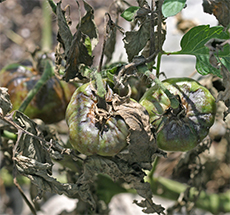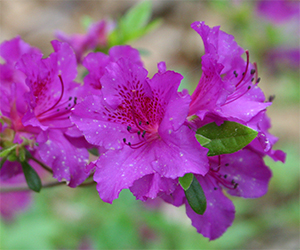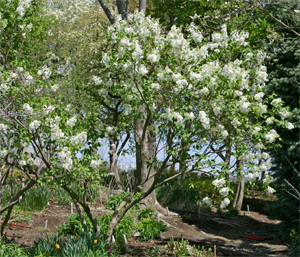May E-News from Viette's Volume 9: No. 5
Lori Jones, Editor May/2013 |

Time to Plant the Vegetable Garden!
For many gardeners,
May is the start of the vegetable gardening season.
Growing your own vegetables is fun, healthy, and saves on your food bill.
Plus, home-grown vegetables have an awesome flavor when fresh picked!
|
|
| Plant of the Month |
 Blueberry Blueberry
(Vaccinium spp.)
Easy to Grow
Sweet, Healthy Treats
Most people don't think of growing blueberries as a landscape plant but these beautiful shrubs make a colorful addition to the garden. They are covered with attractive flowers in early spring, delicious berries in the summer, and gorgeous crimson foliage in the fall. What's not to love! Plus - the berries are really GOOD for you! They are full of fiber, low in fat, packed with vitamin C, and have antioxidant properties!
 | | Little blue dynamos |
A Versatile Accent
As I mentioned, blueberry shrubs make an attractive addition to the landscape providing interest for the entire season. The clusters of white or blush flowers that cover the shrubs in the spring are not only beautiful but give the added bonus of delicious blueberries in the early summer. The shrubs have an attractive shape with lovely deep green foliage throughout the summer. In the fall, the leaves turn a brilliant scarlet and provide striking color in the garden.
 | | Urn-shaped blueberry flowers |
Choosing Blueberries
Blueberries should be planted in a group with at least two different cultivars for best berry production. They can even be planted as a colorful hedge. Choose a nice selection of a few different but compatible varieties. Many cultivars are listed as self pollinating but by planting a variety of different kinds, you will not only improve your berry yield, but you can extend the berry picking season by including cultivars that ripen at different times!
 | | Blueberries are very colorful as they ripen. |
Easy Culture
Blueberries are easy to grow, especially if the planting site is prepared well initially. They should be planted in an area that receives full sun and has good moist soil that is rich in organic matter.
In addition and just as important, they require acidic soil (pH between 4.5 and 5.5). It is important to test your soil first, but most garden soils are not normally this acidic and it's usually necessary to add a soil acidifier. Sulfur in some form is the most effective way to acidify your soil. Straight chemical or elemental sulfur is commonly used and will successfully lower pH if applied according to the label directions. Iron sulfate adds iron to the soil as well as lowering pH. When you plant, mix in plenty of good quality compost and peat moss; this will help retain moisture and nutrients in the soil. Mulch the plants with about 3" of pine mulch or pine needles.
Once planted, blueberries don't require much maintenance except to maintain the lower soil pH and keep them weeded and watered. Add some good compost around the plants in the spring and fertilize them with Holly-tone and some cottonseed meal in the spring and fall.
 | | A February frost coats branches of a blueberry bush. |
Great for ContainersAnother nice thing about blueberries is that they make great container plants! You don't need a big garden space to grow them! Plant them in a large container placed on a deck, patio, or sunny porch. Just remember to plant more than one variety for the best berry production.
Pruning Blueberries
Some minor pruning is recommended on older blueberry shrubs and this should be accomplished in late winter or early spring before growth begins. The best way to prune them is to thin them; removing any crossing branches, broken branches, and weak, drooping branches. You should also remove older branches that are no longer productive and any really twiggy stems, but do not remove more than 20% of the growth in any one season. Tip back branches that are too tall and thin out some of the end twigs to encourage more fruit production.
"Pesky" ProblemsIn general, blueberries have very few pest and disease problems. Animal marauders are the most serious pests that we have had to deal with in our blueberry patch and after sharing them with the deer for a few years, we finally surrounded the whole patch with a welded wire fence. Now we just have the birds to contend with. Every season they take their share and every year we vow to cover the blueberries with netting - maybe this year! But I must say that despite the bird predation, we still pick gallons of delicious blueberries each season. Plant a few blueberry shrubs this spring!
|
|
Join Our List
|

|
If you enjoy our newsletter, please pass it along to your gardening friends!
|
Viette Discussion Board
|
Having trouble getting through on the radio?
Visit our Discussion Board for answers to your gardening questions. Use the convenient search key to see if we have already addressed your problem! Don't see the answer? Post your question! It's EASY, just register as a member. Don't forget to provide your city and state so we can better answer your question.
|
| Gardening Questions? |
Listen to Andre
on the radio every
Saturday morning from
8:00-11:00 on
"In the Garden with Andre Viette"
|
|
|
The Viette Garden Center is Open!
Our shelves are full of amazing daylilies including many of Andre's
beautiful new hybrids!
Our gardens are full of beautiful spring blooming trees, shrubs, flowering bulbs, and early perennials!
Spring Hours: Mon-Fri: 9:30-5; Sat: 9-5; Sun: 1-5
|
Tip of the Month
|
The Importance of Crop Rotation
Crop rotation is one of the golden rules of vegetable gardening.
 | |
Some of the tomato blights can be reduced through crop rotation.
|
Why is it so important to rotate the crops in your vegetable garden?
Crop rotation is one of the simplest ways to reduce the buildup of pests and diseases that affect different groups of plants. In addition, some crops, like beans and peas (the legumes), fix nitrogen during the growing season and add this important nutrient to the soil. Crop rotation takes advantage of these factors and moves groups of plants with similar cultural requirements around the garden in a systematic way.
How do I rotate my crops?
A simple rotation plan divides the vegetable garden into four sections. Vegetable crops are divided into four groups mostly according to family and planted into each of the four sections.
For this rotation plan, the four plant groups are: - Tomato family: tomatoes, potatoes, peppers, eggplant
- Greens and the mustard family: lettuce, spinach, broccoli, cabbage, kale, Brussels sprouts
- Legumes: beans, peas, lentils, soybeans
- Squash family and Corn: squash, pumpkin, melon, cucumber, and corn
Carrots, beets, onions, and garlic can be planted in any of these sections.
 | |
This tomato has been devastated by one of the fungal blights.
|
This simple plan rotates the four groups through each section of the garden so that none is replanted into the same section until the fourth year. The squash family always rotates to where the tomato family was growing the previous year, the tomatoes go where greens were, greens go where legumes were, and legumes go where squash and corn were growing. Easy!
Its Environmentally Friendly
 | |
Mexican Bean Beetles can devastate a bean crop
|
Rotating crops in the vegetable garden reduces the need to spray pesticides and fungicides because it doesn't allow disease organisms to build up in the soil or allow overwintering insects that emerge from the soil in the spring to find their desirable host plants within easy reach.
It just makes sense - an inexpensive, environmentally friendly way to have a successful vegetable gardening experience!
|
|
Meet Mark at Augusta Coop in Staunton, VA
|
Saturday, May 4th from 10am - 12noon
Augusta Coop, Staunton, VA location
1205B Richmond Road, Staunton, VA
 Mark will be at the store from 10am to noon to answer your gardening questions. Don't miss this rare opportunity to talk to Mark one-on-one. Come armed with your plant questions and problems - Mark can help with some simple, easy to understand solutions. Mark will be at the store from 10am to noon to answer your gardening questions. Don't miss this rare opportunity to talk to Mark one-on-one. Come armed with your plant questions and problems - Mark can help with some simple, easy to understand solutions.
|
Growing Vegetables in Containers
|
Short on Space for a Veggie Garden?
 | |
A container of mixed lettuce grows well on a deck.
|
Would you like to have a garden, but you don't have a place to put one in?
Then start a mini-farm! If you have a roof-top, windowsill, patio, deck, or just a doorstep, you can grow vegetables in containers and even harvest year round!
Almost anything that can grow in a garden can also be grown in a container. Just provide your plants with a few basic needs - a suitable container, a growing media, water, nutrients and light, and watch them sprout and grow!
The Containers The containers for your plants must: - be large enough to support your plants when they are fully grown
-
 | |
Growing tomatoes in upside-down containers
|
hold soil - have adequate drainage
Anything that fulfills these basic requirements can be used.
Use your imagination! For example, among the containers that can be used are clay pots, plastic pots, garbage cans, bushel baskets, recycled Styrofoam coolers, wooden crates (lined with plastic so that they will hold soil), barrels, even cement blocks. You don't need to spend a lot of money on containers. You can even build your own planting box out of wood (redwood and cedar are the most rot resistant).
Whatever type of container you use, drainage is extremely important, and may mean the difference between success or failure of your mini-farm. Be sure your containers have drainage holes so that excess water can be drain off freely. The Potting Mix A quality potting mix must be used in your containers. Soil dug from the ground should not be used because these soil particles are normally very small and can cause the soil to become compacted in the container when it is watered. For good plant growth, the soil must remain porous so it can hold both air and water which are vital for healthy plants. A quality potting mix combined with good quality compost makes an excellent container mix that will hold moisture and nutrients well.  | |
A mini-farm planted in
4 side-by-side Garden Soxx
|
A Ready-to-Plant Garden!The Blue Ridge Organics revolutionary new Garden Soxx provides you with everything you need to grow a mini-farm right on your deck or patio! The self-contained Garden Soxx are pre-filled with Blue Ridge Organics "Super Compost" and are ready to plant. They will provide the proper moisture, air circulation, and drainage that will make your plants thrive. The biotic activity within the growing media slowly releases nutrients as your garden grows. Drip irrigation can be added for even simpler growing. Just set your Garden Soxx in a sunny area, plant, and soon you will be harvesting a bounty of delicious vegetables! Care of Containers
Water and sunlight are two very important requirements for your vegetable plants. Most vegetables produce best if provided with full sun so try to place your containers in an area that receives at least six hours of direct sunlight each day. The sun and wind will constantly be drying out your pots so be sure to check your vegetable containers daily and water as needed to keep the soil from drying out but take care not to overwater.
Once the plants have established in the containers, fertilize them with a water soluble fertilizer at the recommended rate listed on the label.
See - ANYONE can grow fresh vegetables!
|
|
On the Viette's Views Gardening Blog
| |
|
|
Pruning Tips for May
|
Pruning Spring
 | | Azaleas should be pruned (if needed) just after they finish flowering. |
Blooming Shrubs
Get your shears ready!
It is (or will soon be) time to prune your spring blooming shrubs like forsythia, lilacs, azaleas, and rhododendron. These shrubs will soon be producing the buds for next year's flowers and if you wait until fall or even mid-summer to prune, you will be cutting off all these flower buds!
Spring blooming shrubs should be pruned right after they finish blooming.
Here are some different pruning methods for these shrubs:
Pruning spent flowers
 | | Removing spent rhododendron blooms |
After the flowers on your spring blooming shrubs have faded, remove the old flowers. This prevents seed formation which can reduce the bloom for the following spring. For azaleas, you can remove about 2"-3" of the branch tips when you shear off the old blooms. With rhododendrons, carefully remove just the dead flower clusters because the new leaf buds are found right behind them. Prune off the spent flower trusses of lilacs just above the first leaves beneath the old blooms.
Pruning and thinning to shape your shrub
Thinning will allow more light to reach the the interior of the shrub. This can lead to a greater production of flower buds the following season. This is especially important for lilacs and forsythia.
 | |
Lilacs respond well to thinning.
|
Thinning can also reduce disease problems such as powdery mildew because it increases air circulation and lowers humidity.Cut several of the oldest stems back to the ground but do not remove more than 20% of the growth. Prune out any crossing branches or wayward stems. Older lilacs can be pruned into small trees by removing all but one or two of the thickest stems and pruning out the lower side branches.
Pruning to reduce size
If your shrubs have become too large for their space, you may need to do some more drastic pruning. One of the best ways to accomplish this is to cut about a third of the oldest stems/branches back to a height that is about 12" lower than the height you want them to be. Once you have done this, prune the remaining stems creatively to create a natural layered look. It may also be necessary to thin out some of the interior branches.
lilacs, azaleas, and forsythia.
|
When You're in the Area
| |
Got Clubs?
Visit our friends at Packsaddle Ridge Golf Club and enjoy a breathtaking round of golf after a visit to the beautiful gardens at Viettes.
Packsaddle Ridge Golf Club received a 5 Star Rating "Best Places To Play" by Golf Digest, 2008/2009. This public 18-hole championship golf course is nestled in the beautiful Shenandoah Valley and features a challenging course with incredible views of the Appalachian Mountains and the valley below.
3067 Packsaddle Trail ~ Keezletown, VA 22832
Phone: 540-269-8188
|
|
|
|
|
|